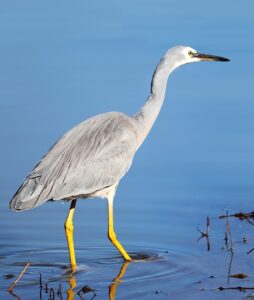
Greetings, readers. Today we learn about water-loving wading birds as we continue our series, Caring for Mother Nature, by my friend, author and naturalist, Peggy Sias Lantz (click her name to visit her website).
Wading Bird Dinner Party
by Peggy Lantz
Our common wading birds get along better than we do. They gather in groups of different species, all feeding at the same trough without conflict, though once in a while one bird will steal another’s catch. They’re all eating pretty much the same things: fish, crayfish, beetles, whatever’s in the water.
When a bird catches a fish, it must throw it up in the air and turn it around so that it can be swallowed head first. Otherwise, the dorsal fin, the one on the fish’s back, will catch in the bird’s throat.
Kinds of wading birds
Most wading birds feed along lake edges, marshes, or shallow brackish lagoons. Each seems to have a unique way of fishing so they don’t have to push each other around.
- White Ibis like the shallow water’s edge, poking their long curved bills into the mud. They may stir up a prey to the surface that a waiting Great Egret standing by may snatch.
- Cattle Egrets follow a herd of cows that stir up grasshoppers and other edibles, including small snakes and frogs. Great Egrets and Snowy Egrets may follow along, too.
- Great Egrets slowly stalk their prey, while the Snowy Egret chases them down.
- Little Blue Herons eat mostly fish, rather than the variety that other wading birds eat. One is often near my dock when I walk down in the morning, standing or walking slowly on the vegetation, looking intently for a fish to swim by. When it sees something, it stabs quickly and sometimes comes up with a bite, but more often, it seems, doesn’t.
- Little Green Herons may sit patiently on a branch over the water, catching a passing fish without letting go of the branch, then swinging back up to swallow it.
- Tricolored Herons often run through the water after prey. So does the Reddish Egret, which is sometimes seen with its wings spread out, presumably to cast a shadow in order to see through the water better, then chasing down its fish.
- The Great Blue Heron usually just stands there, waiting for a fish to swim close enough to be caught. Maybe it’ll be a fish that the Tricolored Heron chased its way. I watched a Great Blue Heron once with a fish too big for it to swallow. The bird shifted it around in its beak several times, dropped it on the ground, picked it up again, washed it off in the water, turned it over and over. I watched for about ten minutes before the heron gave up and flew away, leaving the fish on the shore. I walked down to look, but apparently the fish had managed to flop back into the lake.
- Roseate Spoonbills and Wood Storks feed by putting their beaks in the water and moving them slowly back and forth until something touches them. Then the beak snaps shut faster than the blink of an eye. The Spoonbill likes shallow water and often uses its feet to stir things up a bit.
- Sandhill Cranes it seems eat anything and everything, both in the water and on land. We see them often in our yards around Lake Lucy.
- Then there’s the Anhinga. This bird swims underwater for its fish. It stabs the fish with its beak closed, then surfaces to toss it up and catch it again, head first. Most birds have waterproof feathers, groomed with oil glands at the base of the tail. The Anhinga, however, doesn’t oil its wings. It needs its feathers wet so it can submerge and go after fish underwater. That’s why they can be seen sitting on a bush with their wings held out to dry.
Colonies of wading birds
These wading birds roost and nest together, too, sometimes in great colonies. A large group of White Ibises with Cattle Egrets and a few Great Egrets roost in the bushes at the edge of Lake Lucy. I often watch them flying in at sunset, balancing on the limber branches, jostling for space, and changing places, gradually quieting down. All together on the same bush, eating the same foods, on the same lake.
If birds of a different feather can get along, why can’t we?
—END—
Thanks for reading!
Your writer on the wing,
Charlene







